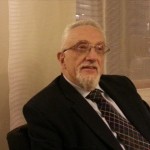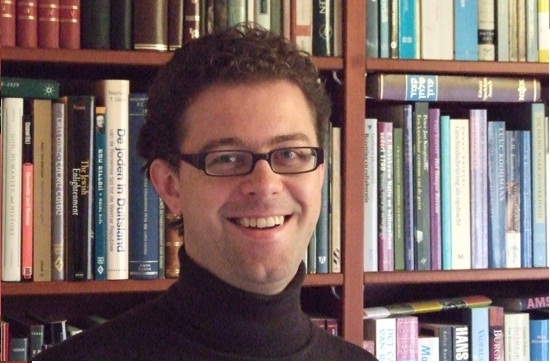This interview with Bart Wallet was published at Israel National News, and republished here with the author’s consent.
Post-War Dutch Jewry: Lessons for Europe
Manfred Gerstenfeld interviews Bart Wallet
 “If one analyzes developments in post-war Dutch Jewry, one can understand much about the history of other European Jewish communities during that period. While some of this history’s aspects are specifically Dutch, others also reflect realities elsewhere in Western Europe.”
“If one analyzes developments in post-war Dutch Jewry, one can understand much about the history of other European Jewish communities during that period. While some of this history’s aspects are specifically Dutch, others also reflect realities elsewhere in Western Europe.”
Bart Wallet is a non-Jewish historian at the University of Amsterdam specializing in the post-war history of Dutch Jewry. Together with others, he has written the book ‘Shehecheyanu’ which describes the post-war history of the Ashkenazi Jewish community in Amsterdam.
Wallet says: “More than 100,000 of the 140,000 Jews who lived in the Netherlands at the beginning of the German occupation in 1940 were murdered. When after the war the Dutch Jewish community re-established itself, this tragic reality greatly influenced it.
“Greater centralization than before the war became necessary. Many Jewish communities could no longer provide services for an integral Jewish life. Therefore, the NIK, the roof organization of Ashkenazi Jewry for example, established a central education commission to enable Jewish children in small towns to receive a Jewish education.
“A second development was that the community became more inclusive. Before the war, those who couldn’t pay membership did not have full rights. The same was true for foreign Jews without Dutch passports. This changed. In various Jewish communities, women were granted the right to vote.
“This greater accent on inclusiveness was also linked to the strengthening of Zionism among Dutch Jews. The Zionists said that whoever had been persecuted as a Jew during the Shoah had to be able to find a place in the Jewish community. The emphasis shifted to the national ethnic definition of Jewish identity from the pre-war religious one.
“The initial post-war increase in the percentage of organized Jewry resulted from the fact that many Jews were left with little or no family. They wanted contact with other Jews. Others wanted to be buried as Jews. At the same time, many Jews did not want to participate in Jewish matters in any way. Some were baptized, while hundreds of others changed their Jewish-sounding surnames.
“Surprisingly enough, some of them returned to Jewish life many years later. The 1967 Six-Day War of Israel triggered those feelings for some, who now identified with Israel. After the war, 500 Jewish children whose parents had been murdered were handed over by the authorities to non-Jewish foster parents who had hidden them during the war. Many of them were raised as Christians. The Jewish community considered them as ‘lost’ regarding Judaism. As adults however, many of them searched for their Jewish roots and identity. Some leading figures in Dutch Jewry even emerged from this group.
“The international Jewish influence on Dutch Jewry also increased, albeit slowly. Initially, this was mainly the case with Israel which sent youth leaders to the Netherlands. Developments in the United States also had an influence. This expressed itself in diverse directions, such as the growth of Liberal communities, as well as the rise of the Chassidic Chabad Movement.”
Wallet remarks: “Any division of history into periods is a construct by historians, yet it is helpful for understanding the past better. The period from 1945 till 1955-1960 was that of re-establishment of the Jewish infrastructure and its adaptation to the new circumstances. During these years, there were tensions between the Jewish community, Dutch authorities and society in general. This was partly caused by the fact that the authorities ignored the specific needs of the decimated Jewish community.
“The period of 1955 until 1967 was characterized by more stability. Amsterdam, where about half of Dutch Jewry lived, increasingly built up its Jewish infrastructure. Other communities declined in number. From 1967 until 1990, the Shoah became the central iconic story of the Second World War in the Netherlands. The Jewish community turned into a kind of moral conscience for Dutch society in which it acquired an important role.
“At the same time, internal polarization increased. A group of ultra- Orthodox Jews emerged in Amsterdam. On the progressive side, there were calls for more democratization, women’s rights and emancipation of homosexuals. These general themes in Dutch society were also prominent among Jews. The liberal Jewish community adopted them, which led to tensions with the nominally Orthodox Ashkenazi community.
“There was also polarization concerning Israel. Small groups which were critical of Israel promoted the Palestinian narrative. More importantly, the major non-Western immigration — mainly of Muslims — led to a Dutch worldview that the Netherlands should be seen as a multi-cultural society. The integrated Jewish community was now also viewed as a cultural minority.
“At the end of the last century, the renewed Holocaust restitution debate received much attention in the Dutch media. After the murder of populist politician Pim Fortuyn in 2002, a new Dutch nationalism surfaced. Pressure upon all religious communities increased. Recently for the Jews, this has meant continuing attacks on their kosher slaughter and circumcision rites.”

